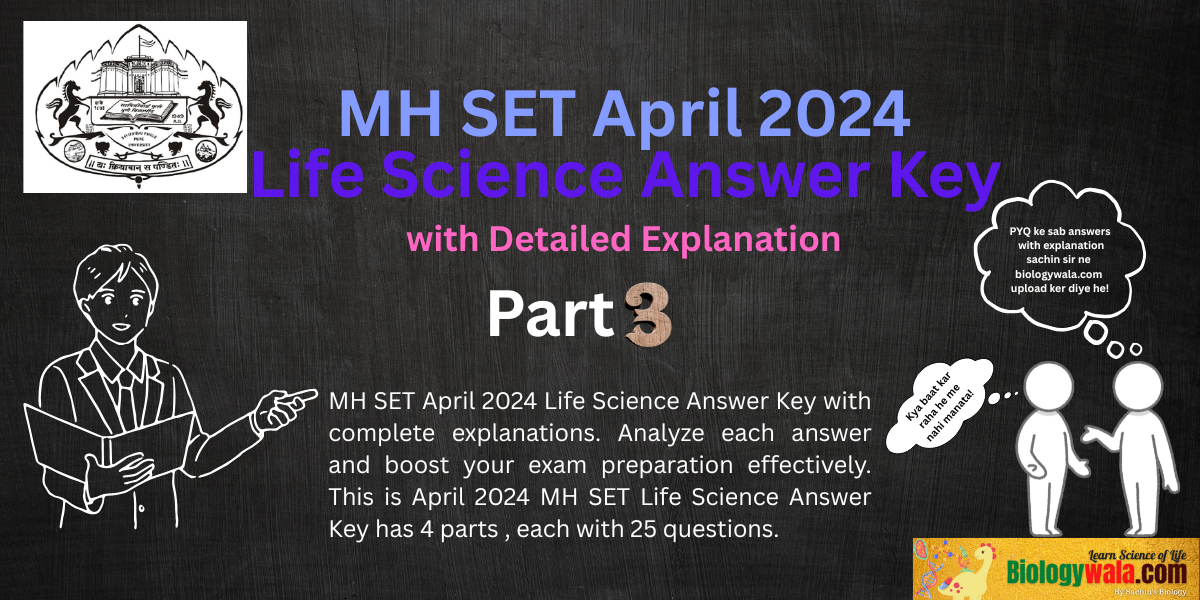MH SET April 2024 Life Science Answer Key with Detailed Explanation: Part 3

Download the MH SET April 2024 Life Science Answer Key with complete explanations. Analyze each answer and boost your exam preparation effectively. This is April 2024 MH SET Life Science Answer Key Part 3.
Q.1 Amplification of a DNA fragment by PCR requires primers. Which of the following statements are correct for primers ?
(i) Primers with hairpin structure formation are not desirable
(ii) Primer sequence should not have long runs (>3) of a single nucleotide
(iii) GC content of the primer should be less than 20%
(iv) Both the forward and reverse primers must have high percentage of base complementarities
(A) (i), (ii) and (iii)
(B) (ii), (iii) and (iv)
(C) (i) and (ii)
(D) (iii) and (iv)
Answer – (C) (i) and (ii)
Explanation:
- Forward and reverse primers should not be complementary to each other to avoid primer-dimer formation.
- Hairpin structures can interfere with primer binding and amplification.
- Long runs of a single nucleotide can lead to mispriming.
- The optimal GC content is usually 40–60%, so less than 20% is too low.
Q.2 When subcultured into fresh medium, a bacterium grows with a lag phase of 2 hours followed by log phase and a stationary phase. If the bacterium was treated with ethidium bromide for 3 hours in all the phases of growth to cure a plasmid, it is more likely to lose the plasmid in :
(A) Early stationary phase
(B) Late stationary phase
(C) Logarithmic phase
(D) Lag phase
Answer – (C) Logarithmic phase
Explanation:
During log phase, cells are actively dividing and replicating DNA, including plasmids. Ethidium bromide intercalates into DNA and inhibits replication, leading to the loss of plasmids during this active replication phase.
Q.3 The free hydroxyl groups present on either end of chemically synthesized. Oligonucleotides are 5’–phosphorylated with ATP by the enzyme :
(A) Polynucleotide phosphatase
(B) Polynucleotide phosphorylase
(C) Polynucleotide ATPase
(D) Polynucleotide kinase
Answer – (D) Polynucleotide kinase
Explanation:
Polynucleotide kinase transfers a phosphate group from ATP to the 5′ hydroxyl end of DNA or RNA.
Q.4 Which one of the following is not a fluorophore ?
(A) Acridine orange
(B) Acrylamide
(C) Quinacrine
(D) Ethidium bromide
Answer – (B) Acrylamide
Explanation:
Acrylamide is used in gel electrophoresis but is not a fluorophore. Others like acridine orange, quinacrine, and ethidium bromide are known DNA-binding fluorescent dyes.
Q.5 Which of the following best describes principle of western blotting technique ?
(A) A means of separation of restriction fragments on the basis of size
(B) It is based on attraction to a specific chemical group
(C) The proteins have a net charge zero at a particular pH
(D) It is an immunoassay technique preceded by electrophoresis
Answer – (D) It is an immunoassay technique preceded by electrophoresis
Explanation:
Western blot involves separation of proteins via SDS-PAGE followed by transfer to a membrane and detection using specific antibodies (immunoassay).
MH SET April 2024 Life Science Answer Key with Detailed Explanation: Part 3
Q.6 Which of the following is resulted due to photorespiration reaction catalysed by oxygenase activity of rubisco ?
(A) 3-phosphoglycerate only
(B) 2-phosphoglycolate only
(C) Fructose 6-phosphate
(D) 3-phosphoglycerate and 2-phosphoglycolate
Answer – (D) 3-phosphoglycerate and 2-phosphoglycolate
Explanation:
Rubisco catalyzes the reaction of RuBP with O₂, producing one molecule of 3-PGA and one of 2-phosphoglycolate.
Q.7 Mutation in ACC synthase enzyme will inhibit synthesis of …………….
(A) Gibberellins
(B) Salicylic acid
(C) Ethylene
(D) Auxin
Answer – (C) Ethylene
Explanation:
ACC synthase converts S-adenosyl methionine to ACC, the precursor of ethylene in plants.
Q.8 Which of the following phytohormone accumulates during Systemic Acquired Resistance (SAR) in plants ?
(A) Salicylic acid
(B) Jasmonic acid
(C) Abscisic acid
(D) Ethylene
Answer – (A) Salicylic acid
Explanation:
Systemic Acquired Resistance (SAR) is a defense mechanism in plants that provides long-lasting protection against a wide range of pathogens. Salicylic acid (SA) is the key signaling molecule involved in the activation of SAR. It leads to the expression of pathogenesis-related (PR) proteins and systemic immunity. Jasmonic acid and ethylene are more involved in local defense responses against necrotrophic pathogens and insects.
Q.9 The hormone auxin was first discovered in :
(A) Mustard
(B) Pea
(C) Oats
(D) Rice
Answer – (C) Oats
Explanation:
Auxin (indole-3-acetic acid or IAA) was first discovered through experiments on Avena (oat) coleoptiles by Charles Darwin and later clarified by Frits Went. He demonstrated that a chemical produced at the coleoptile tip could influence phototropic bending. This led to the identification of auxin as the first plant hormone.
Q.10 How many times more energy gained in aerobic respiration over anaerobic respiration ?
(A) 8
(B) 12
(C) 18
(D) 32
Answer – (C) 18
Explanation:
- Anaerobic respiration (fermentation) yields 2 ATP per glucose.
So, the energy gain is approximately 18 times more in aerobic respiration. This high yield is due to the complete oxidation of glucose in the presence of oxygen, which includes glycolysis, Krebs cycle, and oxidative phosphorylation. - Aerobic respiration yields 36–38 ATP molecules per glucose.
Q.11 Which of the following is NOT involved in electron transport during Photosystem I and II ?
(A) Ferredoxin
(B) Plastocyanin
(C) Cytochrome b6f complex
(D) Cytochrome oxidase
Answer – (D) Cytochrome oxidase
Explanation:
Cytochrome oxidase is part of the mitochondrial electron transport chain (involved in respiration, not photosynthesis).
In photosynthesis, the main components involved are:
- Cytochrome b6f complex – part of the electron transport chain in the thylakoid membrane
- Ferredoxin – terminal electron acceptor in Photosystem I
- Plastocyanin – mobile electron carrier between PSII and PSI
Q.12 The treatment of abscisic acid is associated with …………………
(A) Internode elongation
(B) Expansion of lead area
(C) Closure of stomata
(D) Axillary root elongation
Answer – (C) Closure of stomata
Explanation:
Abscisic acid (ABA) is a plant stress hormone. Under drought or water deficit, ABA levels rise and induce stomatal closure to minimize water loss. It signals guard cells to lose turgor, leading to pore closure. This action helps plants conserve water.
Q.13 Action potential is generated due to :
(A) Influx of Na+ and efflux of K+
(B) Influx of Ca2+ and efflux of K+
(C) Influx of Na+ and efflux of Ca2+
(D) Influx of K+ and efflux of Na+
Answer – (A) Influx of Na⁺ and efflux of K⁺
Explanation:
An action potential is an electrical impulse in neurons. Then, K⁺ channels open, and K⁺ moves out (repolarization).
This flow of ions changes the membrane potential, propagating the signal along the neuron. Initially, Na⁺ channels open, and Na⁺ rushes into the cell (depolarization).
Q.14 Hookworm infection can lead to deficiency of :
(A) Vitamin B12
(B) Iron
(C) Vitamin B6
(D) Folic acid
Answer – (B) Iron
Explanation:
Hookworms (like Ancylostoma and Necator) attach to the intestinal lining and feed on blood. Chronic infection causes blood loss, leading to iron-deficiency anemia. Symptoms include fatigue, weakness, and pallor.
Q.15 What kind of microbes grow best at higher CO2 tension (~ 10%) than are normally present in the atmosphere ?
(A) Microaerophilic microorganisms
(B) Capnophilic microorganisms
(C) Aerotolerant anaerobic microorganisms
(D) Obligate anaerobic microorganisms
Answer – (B) Capnophilic microorganisms
Explanation:
Capnophiles are bacteria that thrive in environments with higher levels of CO₂ (5–10%), such as Neisseria gonorrhoeae and Campylobacter spp. These microbes are often grown in special incubators or jars with elevated CO₂ for optimal growth.
MH SET April 2024 Life Science Answer Key with Detailed Explanation: Part 3
Q.16 Which free living microorganisms occupy a niche to feed primarily on organic detritus from dead organisms and unable to adapt to the body of live host ?
(A) Obligate saprobic microorganisms
(B) Parasitic microorganisms
(C) Facultative parasitic microorganisms
(D) Auxotrophic microorganisms
Answer – (A) Obligate saprobic microorganisms
Explanation:
Saprobes are decomposers that break down dead organic matter. Obligate saprobes can survive only on dead material and do not infect or live in living organisms, unlike parasitic or facultative organisms.
Q.17 The DNA of each chromosome occupies a defined volume of the nucleus and only overlaps with its immediate neighbours is called as :
(A) Chromosome territories
(B) Nuclear scaffolds
(C) Nucleosome assembly
(D) Chromatin
Answer – (A) Chromosome territories
Explanation:
In the interphase nucleus, each chromosome occupies a distinct 3D space called a chromosome territory. This spatial organization aids in gene regulation and prevents entanglement between chromosomes.
Q.18 Amphibians contain 30X more DNA than human beings. However human beings are more complex than amphibians. This lack of correlation is called as :
(A) Species specificity
(B) C-value paradox
(C) D-value paradox
(D) P-value paradox
Answer – (B) C-value paradox
Explanation:
The C-value paradox refers to the observation that genome size (C-value) does not correlate with organismal complexity. For example, some amphibians or plants have much larger genomes than humans, yet are simpler. This is due to repetitive, non-coding DNA and transposable elements.
Q.19 Which one of the following is not true in relation to eukaryotic gene expression ?
(A) RNA POl I synthesizes pre- γRNA
(B) RNA POl II synthesizes γRNA
(C) RNA POl III synthesizes tRNA
(D) All three polymerase contains β’, β, α and ω subunits
Answer – (B) RNA Pol II synthesizes γRNA
Explanation:
Eukaryotic RNA polymerases:
- RNA Pol III – tRNA, 5S rRNA, and some small RNAs
Also, they do not share the same subunit composition as bacterial polymerases (β’, β, α, ω). So statement (B) is false due to incorrect terminology (“γRNA”). - RNA Pol I – rRNA (except 5S rRNA)
- RNA Pol II – mRNA (not γRNA)
Q. 20 The triple helix domain of collagen consists of repeats of the X-Y-Z amino acids. The amino acid present at ‘X’ position is required in every third position in order for the polypeptide chain is :
(A) Lysine
(B) Proline
(C) Hydroxy proline
(D) Glycine
Answer – (D) Glycine
Explanation:
- Collagen has a repeating Gly-X-Y sequence, where:
- X and Y are often Proline and Hydroxyproline, which provide structural stability.
- Glycine is every third residue – its small size allows tight packing.
MH SET April 2024 Life Science Answer Key with Detailed Explanation: Part 3
Q.21 Which DNA binding domain is present in steroid hormone receptors family of ligand inducible transcription factors ?
(A) Helix-loop-helix
(B) Zinc fingers
(C) Helix-turn-helix
(D) Leucine zipper
Answer – (B) Zinc fingers
Explanation:
Steroid hormone receptors (e.g., estrogen, glucocorticoid receptors) use zinc finger domains to bind DNA. These domains coordinate zinc ions to maintain a stable fold that fits into the major groove of DNA.
Q.22 Which of the following elongation factor is called as translocase ?
(A) EF-G
(B) EF-2
(C) EF-G and EF-2
(D) EF-Tu and EF-Ts
Answer – (C) EF-G and EF-2
Explanation:
- In eukaryotes, the equivalent is EF-2. Hence, both are termed translocases.
- In prokaryotes, EF-G assists in moving the ribosome along mRNA (translocation).
(A) Histone acetylation
(B) Sumoylation
(C) Ubiquitination
(D) DNA methylation
Answer – (C) Ubiquitination
Explanation:
Epigenetic regulation involves heritable changes in gene expression without altering DNA sequence. Key modifications include:
- Histone acetylation – opens chromatin
- DNA methylation – represses gene transcription
Ubiquitination mainly marks proteins for degradation and is not a major epigenetic regulator.
Q.24 The disease which arises because of aberrant splicing is :
(A) Huntington’s disease
(B) Cystic fibrosis
(C) Sickle cell anemia
(D) Thalassemia
Answer – (D) Thalassemia
Explanation:
β-thalassemia often results from mutations in splice sites of the β-globin gene, leading to defective mRNA and reduced or absent β-globin chain production. This causes imbalanced hemoglobin synthesis and anemia.
Q.25 Identify the enzymes involved in DNA replication for their function :
(Enzyme)
(P) DNA polymerase I
(Q) Primase
(R) Helicase
(S) Gyrase
(Function)
(1) Unzipping the DNA helix
(2) Supercoiling of DNA
(3) Remove primer and close gaps
(4) Synthesize RNA primer
(A) (P)-(2),(Q)-(3),(R)-(4),(S)-(1)
(B) (P)-(3),(Q)-(4),(R)-(1),(S)-(2)
(C) (P)-(1),(Q)-(4),(R)-(2),(S)-(3)
(D) (P)-(3),(Q)-(1),(R)-(2),(S)-(4)
Answer – (B) (P)-(3),(Q)-(4),(R)-(1),(S)-(2)
Explanation:
- Gyrase (a type of topoisomerase) relieves torsional strain ahead of the fork by introducing negative supercoils.
- DNA polymerase I has 5’→3′ exonuclease activity to remove RNA primers and fills in DNA.
- Primase synthesizes short RNA primers to initiate replication.
- Helicase unwinds the DNA helix at the replication fork.
More: MH SET April 2024 Life Science Answer Key with Detailed Explanation
- MH SET April 2024 Life Science Answer Key Explanation: Part 4 (Will be uploaded 11th June 2025)
- MH SET April 2024 Life Science Answer Key with Detailed Explanation: Part 1
MH SET Life Science Question Paper PDF Download
Read more:
We hope you liked MH SET April 2024 Life Science Answer Key with Detailed Explanation: Part 3
Join SACHIN’S BIOLOGY on Instagram or Facebook to receive timely updates and important notes about exams directly on your mobile device. Connect with Mr. Sachin Chavan, the founder of Sachin’s Biology and author of biologywala.com, who holds an M.Sc., NET JRF (AIR 21), and GATE qualifications. With SACHIN’S BIOLOGY, you can have a direct conversation with a knowledgeable and experienced professional in the field of biology. Don’t miss out on this opportunity to enhance your exam preparat
![[PDF] Embryology in Relation to Angiosperms Taxonomy | 7 Role of Embryology in Taxonomy 2 [PDF] Embryology in Relation to Angiosperms Taxonomy | Role of Embryology in Taxonomy](https://biologywala.com/wp-content/uploads/2023/08/Embryology-in-Relation-to-Taxonomy-in-Angiosperms-520x245.webp)

